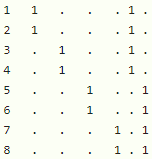I have a standard split-plot design, having the three predictors:
- A :: [ Categorical, Unordered, 2 Levels ] --> (1, 2)
- B :: [ Categorical, Unordered, 4 Levels ] --> (1, 2, 3, 4)
- C :: [ Categorical, Unordered, 2 Levels ] --> (1, 2)
Predictor B indicates the main plots, Predictor A indicates the treatment applied to entire main plots, and Predictor C indicates the treatment applied to the subplots within main plots.
The three crossed/nested pairwise relationships are:
- A -- C :: A is crossed with C
- A -> B :: A nests B (i.e. B is nested within A)
- B -- C :: B is crossed with C
An example data set containing 8 measurements (but only showing the predictor information, not the measured responses) for this example experiment can be written in table format:
| A | B | C | |
|---|---|---|---|
| 1 | 1 | 1 | 1 |
| 2 | 1 | 1 | 2 |
| 3 | 1 | 2 | 1 |
| 4 | 1 | 2 | 2 |
| 5 | 2 | 3 | 1 |
| 6 | 2 | 3 | 2 |
| 7 | 2 | 4 | 1 |
| 8 | 2 | 4 | 2 |
I would like to model this design as a mixed model using lme4's lmer() function, but I am confused as to the correct model formula. I see two options...
Model 1
R ~ A*C + (1|B)
This model formula has the random effects design matrix:
...and a random effects covariance matrix:
Model 2
R ~ A*C + (1|A/B)
This model formula has the random effects design matrix:
...and a random effects covariance matrix:
Both models have the same fixed effect design matrix.
Model 2 seems to properly depict predictor B as nested within A, but it seems strange to put A as both a fixed effect and a random effect.
My question is: which of these two models is correct, and why?




